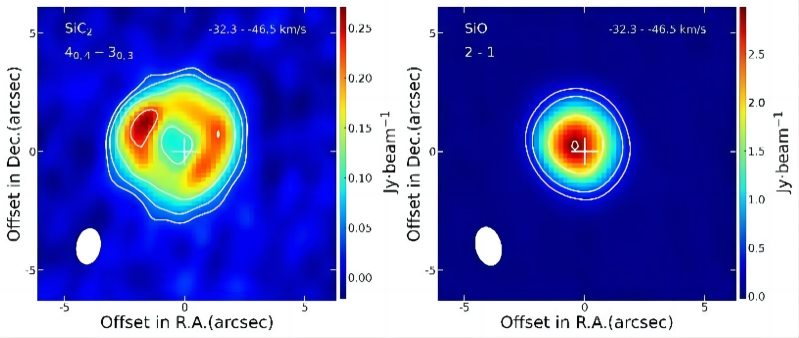

Researchers Discovered Annular Distribution of SiC2 towards carbon-rich AGB stars by ALMA Observations
The circumstellar envelopes (CSE) of asymptotic giant branch (AGB) stars contain a large number of molecules (105 have been detected), which account for about one-third of all molecules discovered in interstellar space (over 300). Studying the physical and chemical properties of molecules in CSEs is crucial for understanding stellar evolution.
Gas and dust are essential components of CSEs, and SiC2 is one of the significant constituents of dust grains in carbon-rich AGB stars. Whether SiC2 is "parent" molecules formed in the photosphere or during the high-temperature dust formation process (exhibiting a "solid" spatial distribution), or if it is a "daughter" molecule formed through photodissociation of "parent" molecules in the outer envelopes (exhibits an annular distribution), is a debate existing for a long time.
FENG Yanan, a Ph.D. candidate under the guidance of Prof. LI Xiaohu from the AstroChemistry Group of the Xinjiang Astronomical Observatory (XAO) of the Chinese Academy of Sciences, together with their collaborators, have conducted observational work on the SiC2 molecule towards three carbon-rich AGB stars (AI Vol, II Lup, and RAFGL 4211) using the Atacama Large Millimeter/Submillimeter Array (ALMA).
The study was published in Frontiers in Astronomy and Space Sciences on Aug. 14, 2023.
The results revealed that the spatial distribution of the four rotational transition spectral lines of SiC2 molecules around these three sources exhibited an annular distribution, indicating the feature of a typical "daughter" species. This finding contradicts the previous simple assumptions in the astrochemical models and provides new insights into the understanding of circumstellar chemistry.
The researchers compared the ALMA results of SiC2 and SiO molecules in AI Vol (Figure 1). Apparently, the SiO molecule exhibited a "solid" distribution feature, indicating that it is a "parent" molecule, which is consistent with the previous studies. “In future studies, people need to rethink the formation mechanism of SiC2 in the CSEs of evolved stars,” said Prof. Li.

Figure 1. ALMA observation results of SiC2 (left panel) and SiO (right panel) molecules toward the carbon-rich AGB star: AI Vol.
Contact: FENG Yanan
Xinjiang Astronomical Observatory, Chinese Academy of Sciences
Email: fengyanan@xao.ac.cn
Article link: https://www.frontiersin.org/articles/10.3389/fspas.2023.1215642/full
Attachment Download: